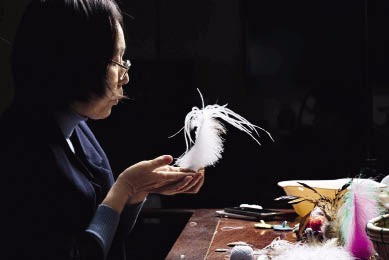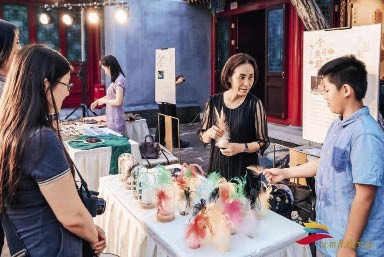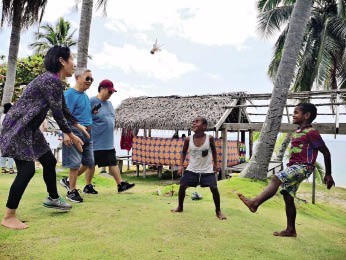The game of kicking shuttlecocks, favored by both the elderly and the young, has a long history in China. A shuttlecock is light and beautiful, and the whole activity is easy to participate in, so people have a fondness for it.

Yin Wen, the fourth-generation inheritor of the handicraft of making Tang Qian Yan shuttlecocks, is carefully preparing feathers for a shuttlecock in her studio.
Among the many types of shuttlecocks, Tang Qian Yan shuttlecock, an intangible cultural heritage in Dongcheng District, Beijing, attracts much attention. Yin Wen, the fourth-generation inheritor of the manufacturing skills of Tang Qian Yan, became deeply enamored with its charm and has since inherited the craftsmanship and carried forward its history and culture.
A Long History
Shuttlecock kicking is a popular sport that has a long history in China. In Miscellany of the Customs of Beijing of the Qing Dynasty (1644-1911), it is written that a shuttlecock can be made by sewing leather and copper coins together, tying eagle feathers together, and then fastening them with leather straps. There are as many as 100 ways to kick shuttlecocks. During the reign of Emperor Guangxu of the Qing Dynasty, there was a centenarian scholar who could play the game in dozens of ways.
It is documented that shuttlecock kicking came into being in the Han Dynasty (206 BC-AD 220) and became popular in the Sui (581-618) and Tang (618-907) dynasties. In the book The Source of Things published in the Song Dynasty (960-1279), it is recorded that, “Nowadays, children take lead and tin flakes as copper coins, tie chicken feathers onto them and call them jianzi, which is then kicked in groups of three or four during walking or running.” During that time, the game could also be played while running.

Yin Wen introduces Tang Qian Yan shuttlecocks to visitors at Dongsi Hutong Museum in Beijing on June 28, 2019.
During the Ming (1368-1644) and Qing dynasties, the game became more popular and the kicking skills were greatly improved. According to A Book of Customs of the Imperial Palace and Capital City Beijing, shuttlecock kicking was practiced and admired by the residents of Beijing. “There were professional shuttlecock kickers outside the city gates. They played the game like dancers without stop, which was quite impressive!” reads the book.
Yin said that during the Qing Dynasty, the imperial concubine Jin was very fond of shuttlecock kicking. Every afternoon, she took her eunuchs and maids to the imperial garden to kick shuttlecocks together. During the game, she never thought of her superiority, but tucked her skirt in her waist, and kicked shuttlecock in a team with her servants. Jin was quick in her movements, knowing how to kick it in front of and behind her and kick it to her right and left, which often led to applause from those who played with her. It was quite a scene to see them kick it merrily after a snow fall in the imperial garden.
The craft of making Tang Qian Yan shuttlecocks has a history of about 100 years, and it is recorded that it began in the 1910s. White ones are always seen as the best of all Tang Qian Yan shuttlecock, while colored ones are for good performance effects. Tang Qian Yan products have two basic categories: one is those made of chicken feathers, and the other from eagle feathers. Generally, a shuttlecock of chicken feathers has six feathers, which carries an auspicious meaning of everything going smoothly as “six” in the Chinese language is a homophone of “smooth.” The shuttlecock made from chicken feathers is light and suitable for play in daily life, while those made of eagle feathers are relatively bigger. As eagles are national protected animals, modern alternatives are cormorant, turkey, and ostrich feathers. These alternatives are very good choices as the products made of them are not only graceful, but also durable.
In 2008, Tang Qian Yan products were the only shuttlecocks selected for performance during the Beijing Olympic Games. In 2017, the Tang Qian Yan craft was certified as an intangible cultural heritage by Dongcheng District, Beijing.
The Craft of the Tang Qian Yan Shuttlecock
Yin Wen is the fourth generation inheritor of the Tang Qian Yan craft. She knows too well how to cut backing cloth, select good feathers, match colors, and stitch the material according to traditional methods. After several processes, she turns the combination of feathers and material into an elegant visual art.
To make a Tang Qian Yan shuttlecock, you need several feathers, two copper coins, and several inches of cotton cloth. First, the base needs to be prepared. Sew three or four round pieces of leather with a diameter of four to five centimeters surrounding the ancient copper coins to form a pad. Encasing the coins in the leather implies that money is not exposed, which reflects the Chinese traditional culture of keeping a low profile and being modest when one becomes wealthy. While sewing with threads, care should be taken in avoiding tying fast knots as there is a symbolic connotation with “fabricating a knot (homophone of conflict in Chinese)” with others in our lives. But could a shuttlecock be strong enough without knotting the threads in it? Of course, Yin would tie a special knot which is both tight and easily untied.

Yin kicks shuttlecock with local children on Dravuni Island during a cultural communication event on December 24, 2019.
After making the base, the next step is to select and deal with the feathers. A single feathered shuttlecock is very rare as it is difficult to find fluffy enough feathers. The common type consists of more than two feathers, usually taking two equally supple feathers and placing them back to back. Generally, the height of a shuttlecock is no more than 12 centimeters, so that it will turn upside down quickly in the air when being kicked. The feathers are tied together with a thread at their base with a special knot. Then the feathers are fastened two to three times with a thin thread about two centimeters from the bottom. This procedure is repeated at four and six centimeters from the bottom. In this way, the feathers are perfectly fixed, and the downward feathers lie straight, symbolizing the unyielding spirit of the Chinese people.
Then the feathers need to be cleaned. Put them in cold or warm water, and wash them along their veins. This is called a “beauty bath.” After washing, dry the feathers with a piece of cloth in the natural direction of their veins. Then gently shake them until they are fluffy in the natural wind. The process does not take too long.
The cleaned feathers are placed in the copper base and fastened with loops of threads. The threads must not be loose, or the semi-finished product will not be strong. The end of the threads must be twisted together to avoid a fast knot. Finally, trim the finished product to keep it within a height of 12 centimeters.
The whole process is not complicated, but it needs great patience. The craft requires the artist to put aside all that’s bothering him or her and sit down with a carefree heart, so that they can produce a perfect shuttlecock.
Philosophies behind the Craft
Even though a shuttlecock is small, it is imbued with Chinese philosophies. Kicking with legs is also interesting. Yin said there are generally five types of kicking: kicking it alternatively with the inside of the feet, with the outside of the feet, with the insteps, with the knees, or with the outside of the feet but with a halt on the instep.
There are many tips. It is very graceful when one kicks it alternatively with the inside of their feet. When kicking with the knees, the thighs need to be parallel to the land, which makes it easy to apply force.
When people kick the shuttlecock, they will mix and match various ways in different combinations. Colorful feathers flutter to and fro from everyone’s feet, leaping into the air in beautiful arcs, while everyone involved laughs merrily. If one shuttlecock is broken, there is no need to throw it away, as it can be repaired. For Yin, in the process of repairing the shuttlecock, she feels quite relaxed both mentally and physically.
Nowadays, with the government attaching great importance to intangible cultural heritage, many cultural and tourism projects in Beijing invite visitors to experience the making of Tang Qian Yan shuttlecock. Not only the middle-aged and elderly, but also many young sports lovers are fond of this fun-filled craft. Making a shuttlecock with their own hands gives them a great sense of achievement and enables them to have a deeper understanding of traditional culture through personal experience.
Yin has also been invited to promote the intangible cultural heritage item overseas. In places such as the Philippines, Fiji, and Tonga, accompanied by gentle sea breezes, she kicks shuttlecock together with local people. People from different countries learn about Chinese culture and interact with each other in a friendly and playful way during the exercise.